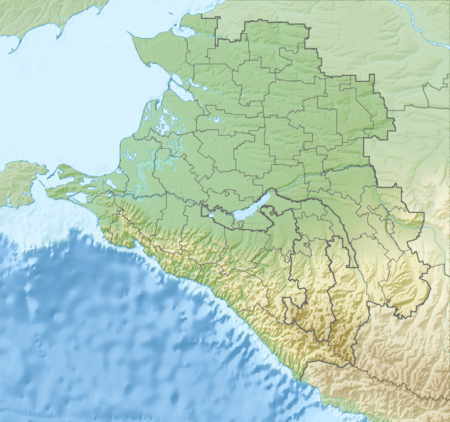Akhshtyrskaya Cave
| Akhshtyrskaya Cave | |
|---|---|
| Big Kazachebrodskaya Cave | |
|
Exterior entrance to the cave | |
 | |
| Location | Kazachy Brod, Krasnodar Krai, Russia |
| Coordinates | 43°31′10.92″N 39°59′38.63″E / 43.5197000°N 39.9940639°ECoordinates: 43°31′10.92″N 39°59′38.63″E / 43.5197000°N 39.9940639°E |
| Depth | 160 |
| Geology | limestone, corrosion-erosion |
Akhshtyrskaya cave ( Big Kazachebrodskaya ) is an important archeology site in the Western Caucasus . It is located on the right side of Akhshtyrskaya gorge of the Mzymta River near the Adlersky City District of Sochi, Krasnodar Krai, Russia. It was discovered in September 1903 by Edouard Martel and Gabriel Revinko, a resident of the nearby village of Kazachy Brod.
Description
The cave entrance is located about 120 m above the Mzymta river (185 meters above sea level) with an eastern exposure. It extends 160 meters deep into the rock: first forming a 20-meter corridor, and then splits into two halls, 10 and 8 meters, wide. Further on, there is a sharp rise of clay, and two narrow courses, coming to a dead end. Near the cave entrance, there are two areas, connected by a 12-meter corridor.
In 1978, in the cave received the status of "a unique monument of architecture of the primitive", the entrance to the cave was closed, and the hallway is blocked by iron bars. In 1999, the cave became accessible to the public. The cave is equipped with artificial lighting, stairs and steps.
The cave is named from the local village of Akhshtyr, It's alternate name from the village of Kazachy Brod.
Discovery and Excavations
The Akhshtyrskaya cave was discovered in September 1903 by Édouard-Alfred Martel and Gabriel Revinko, a resident of the nearby village of Kazachy Brod. In 1936, the archaeologist Sergei Nikolayevich Zamyatin discovered prehistoric human remains. His research and excavation occurred in 1937-38. In 1961 though 1965, excavation was continued by Leningrad archaeologists MZ Panichkina and EA Vekilova. The archeological strata, about 5 meters thick, range from the Middle Paleolithic era to the early medieval period. More recent studies occurred from 1999 until 2008. In total, more than 6000 bones were found - 92% of which belonged to the cave bear. In addition, there are the remains of deer, bison, goats, wolves, foxes and other animals. The first humans, Neanderthals , settled in the cave about 70 thousand years ago. Then there was a break of about 20,000 years. And about 30-35 thousand years ago the cave was populated by modern, Cro-Magnon, humans.
Results
Layer Dating: Layer 3/1: 40,000 yrs BC; Layer 4/1: 70,000 yrs BC; Layer 4/2: 80,000 yrs BC; Layer 5/1: 112,000 yrs BC; Layer 5/2: 200,000 yrs BC; Layer 6/1: 250,000 yrs BC; Layer 6/2: 270,000 yrs BC; Layer 7: 300,000 yrs BC; Layer 8: 300,000 yrs BC; Layer 9: 350,000 BC
Description and Findings

Finding (2005): mandible of cave bear; hip bone of cave bear; radius; humerus; cervical vertebrae; rib; vertebrae; lumbar vertebrae; thoracic vertebrae;
Excavation (2005): Level 3 Mousterian. This level is associated with Neanderthal culture at about 40,000 BC. Some cave bear relics were found. Possible, ancient people hunted for him, and eating it. Black spots inside the levels of cave may be the result of fire usage for cooking and warming. The scientists also found some tools: knives, spears and axes.
Section (2005): Rock bottom of the cave. Starting about 350,000 years ago. Layer 9: 350,000 BC; Layer 8: 350,000-300,000 BC; The cave was not habitable and was filled with water. Layer 6/2, 6/1: About 250,000 years BC. Tools were found showing Neanderthal habitation; Layer 5/2, 5/1: 112,000 years BC. First level of long-term habitation of Neanderthal people. Layer: 4/2, 4/1: 70,000 years BC. Second level of long-term habitation of Neanderthal people. Layer 3: 40,000 years BC. Late paleolithic. Stone object of possible Cro-Magnon culture.
The color of the layers show the temperature changes outside the cave. The dark-brown color is due to warm and high wet climate (7, 5/1, 4/1, 3/1). The lilac and gray color is due to cold and high wet climate (6/2, 6/1, 5/2, 4/2). A temperate climate occurred about 70,000 years BC.
Gallery
Photographs of the cave and immediate area.
References
- VI Borisov. Реки Кубани. - Krasnodar : Kubánskoye knizhnoye izdatelstvo, 2005 . - 120 pp.
- SA Kulakov. О плане музеефикации Ахштырской пещерной стоянки. - 3-я Кубанская археологическая конференция: Краснодар-Анапа, 2001. - pp 70–74..
- SA Kulakov, Baryshinkov GF, GM Levkovskaya. Некоторые результаты нового изучения Ахштырской пещерной стоянки (Западный Кавказ). Кавказ и первоначальное заселение человеком Старого Света. - St. Petersburg : Peterburgskoye Vostovedeniye, 2007, pp. 65–81.
- BR Mavliukov, IA Kusi. Черноморское побережье Кавказа от Туапсе до Адлера: путеводитель. - Simon-Press, 2000 . - 272 p. - ISBN 5-93606-004-7




.jpg)